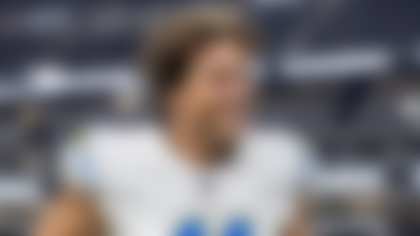After trying to project Week 17 rest-versus-reps strategies for teams that had already clinched playoff spots -- which I complain about having to do but secretly love -- it's finally time to switch over to January football.
I did project before the season that the Saints and Chiefs would meet in the Super Bowl (Really! You can check it out HERE) and the nerdy math coder in me thinks it's pretty cool that they both earned No. 1 seeds. Overall, my regular-season model (record of 167-87-2 in game picks) culminated in a pre-Week 17 projection that got the playoff teams and their respective seeds correct. Things certainly don't always go as my math predicts, but the point I am trying to make here is that my model adapts and learns as it's fed with more information and I'm constantly updating it to reflect the most current trends, situations, matchups and strategies.
Now, the best part of the playoffs is that teams have to win to advance, meaning each club should maximize all 60 minutes of play in every game. My 15-season historical playoff model is like my regular-season model in that it factors in the observed characteristics, trends, play-calling and matchup results of teams in each game. However, the playoff model takes it one step further by adding increased emphasis on outcomes in Weeks 12-16. Don't worry -- Weeks 1-11 are still included, but I have found that putting greater weight on recent play significantly improves the accuracy of the model. As teams' units work together over the course of the season, they evolve and their efficiency and effectiveness can change. This can be positive (often for improving defenses or a rookie quarterback adjusting to NFL game speed) or negative (like for offenses when defensive strategies catch up to their new plays or for teams that lose key players to injury). The attributes of current playoff teams are compared with the historical data to create the projections.
I ran my playoff model, and here are the results for each NFC team's chance to win the conference title and the Super Bowl. I also added a note for each team on an area where they have a predictive flag for being strong, and where they might be vulnerable. Teams are listed in order of the seed they hold, from No. 1 to No. 6.
1) New Orleans Saints
Win NFC: 32.2 percent.
Win Super Bowl: 16.9 percent.
Strength: Special teams.
The Saints have the most well-rounded total team efficiency numbers for the regular season, which is reflected in the percentages listed above, but two specific figures that often fly under the radar are their league-best average starting field position (their own 31.5-yard line) and their third-ranked defensive starting position (their opponents' 26.3-yard line). Here's how it all works together: With that average starting field position supporting their efforts, the Saints have posted the greatest percentage of first downs netting 4-plus yards (56.9), while scoring 2.94 points per drive, second most in the NFL. Meanwhile, the favorable defensive starting field position helps maximize the impact of New Orleans' excellent run defense (3.6 yards allowed per rush, second best in the NFL) and minimize the negative impact of its 29th-ranked pass defense (268.9 passing yards allowed per game), leaving them with a not-terrible points-allowed-per-drive figure of 2.1 (20th in the NFL).
Area of concern: Penalties.
Excluding the Week 17 loss to the Panthers, for which Drew Brees and Alvin Kamara sat out, the Saints' scoring took a hit at the end of the season, dropping from 36.5 offensive points per game in Weeks 1-12 to 19.0 in Weeks 13-16. Their third-down conversion percentage also went from 46.8 in Weeks 1-12 to 39.7 in Weeks 13-16, and their turnover average went from 0.8 per game to 1.5. In their first 11 games, the Saints averaged only 2.1 offensive penalties for 17 yards per game (the second-lowest average for the third-fewest yards) and 2.2 defensive penalties (for 24.2 yards per game). In Weeks 13-16, these numbers jumped to 3.8 offensive penalties (for 31.8 yards per game) and 3.0 defensive penalties (for 42.3 yards per game). The Saints' defense allowed the highest regular-season opposing passer rating among playoff teams (100.3, ranked 27th overall). The issue of giving up extra yards on defense was already problematic before taking into account an uptick in offensive penalties, especially if the Saints aren't able to score touchdowns at the same pace as they did early in the season.
2) Los Angeles Rams
Win NFC: 23.3 percent.
Win Super Bowl: 13.1 percent.
Strength: Big-play balance.
No other team this season had more than 200 pass completions of 10-plus yards and over 60 rushes of 10-plus yards. The Rams had 64 rushes of 10-plus yards (tied for third most) and 202 completions of 10-plus yards (tied for second most). The Rams used 11 personnel (1 RB, 1 TE, 3 WRs) on 91.2 percent of their snaps, the most by any team and over 15 percent more than the second-ranked team. Their three-wide-receiver looks help disguise runs, and the presence of their elite running back (Todd Gurley) helps keep defenses from anticipating the pass.
Area of concern: Run defense, especially in the middle.
Overall, the Rams' defense owns the league's worst regular-season rushing average allowed (5.1 yards per rush). They rank 28th in rushing average when opposing offenses run behind their center (4.89 yards allowed per rush). Over their past five games, they've allowed 5.1 yards per rush on first downs and have been more susceptible to runs away from Aaron Donald's side. Offensive coaches often try to mute the impact of exceptional pass rushing defensive fronts by running right at them. The Rams' opponents have found success this season by using multiple blockers on Donald and then rushing away from his side.
3) Chicago Bears
Win NFC: 15.0 percent.
Win Super Bowl: 8.9 percent.
Strength: Defensive balance.
Over their past five games, the Bears' defense has allowed only four touchdowns total (fewest in the NFL), or 0.8 per game. That puts a nice bow on their excellent start: They allowed just 23 in their first 11 games (2.1 per game, tied for fourth in the league). They've allowed 23 big plays (rushes of 10-plus yards and receptions of 20-plus yards combined) in their final five games, which ranks second; their overall season total of only 67 allowed paces the league and is 15 fewer than the next best team. Chicago is also allowing 3.8 yards per rushing attempt (fourth best) while collecting 50 sacks (tied for the second most) and 36 takeaways (most in the NFL). In other words, the traditional stats show how the Bears have smothered offenses on rushing downs to create very unfavorable passing situations, resulting in the Bears generating disruptive pressure or stopping drives on the highest percentage of plays (31.3) in the NFL.
Area of concern: A lack of passing diversity.
In their past five games, the Bears have only completed 10 passes of 20-plus yards, tied for 25th, and 33 passes of 10-plus yards, tied for 28th, and they only have 24 big plays (pass plays of 20-plus yards and run plays of 10-plus yards), which is tied for 26th. On early downs all season, the Bears averaged just 4.1 yards per rush (ranked 27th). They also rushed the ball on 31.2 percent of their third-down plays, which was the third-highest rate, meaning the low passing numbers partially come from fewer attempts (they rush at the sixth-highest percentage overall, 46.2). However, they have the 11th-best third-down conversion rate on the season (41 percent) and extend drives despite a low per-carry average and low volume of intermediate and deep passes because of their extremely effective use of short passes. The Bears have completed 265 of 334 pass attempts (79.3 percent) between 1 and 10 air yards, according to Next Gen Stats, and 87 of 105 (82.9 percent) over their past five games. The problem is that between wide receiver injuries and below-average wide receiver efficiency (as I explained here), if their short passing falters or if the Bears' defense gives up too many points, they project to have a very difficult time catching up.
4) Dallas Cowboys
Win NFC: 13.1 percent.
Win Super Bowl: 5.7 percent.
Strength: Linebacker play.
Long, fast and rangy linebacker play changed the Cowboys' season, most visibly in their home upset win against the Saints in Week 13. Stopping the run has been a major driver in their ability to win the NFC East. The Cowboys allow the fifth-lowest yard-per-carry average (3.8) on the season, while Leighton Vander Esch and Jaylon Smith have combined to hold opposing offenses to 4 yards or less on more first-down rushing attempts than any other duo. This is a huge factor in the playoffs, as effective rushing offenses have a high rate of playoff success. Their opponent on Wild Card Weekend, the Seattle Seahawks, has the NFL's No. 1 regular-season rushing offense. Notably, in the Super Bowl era, 30 of the 36 teams to make the postseason with the NFL's No. 1 rushing offense have advanced to at least the Divisional Round.
Area of concern: O-line health.
No running back has more yards after contact this season than Ezekiel Elliott (950, per Pro Football Focus). Combine that with his yards after the catch (592), factor in how much extra attention he gets (he has 117 carries against a loaded box, second-most in the NFL, according to Next Gen Stats), and his scrimmage-yards total (2,001 in 15 games) is huge, not only because it supports what we all can see -- that he's the key -- but also because it means other defenses always need to make a special plan to stop him. With guard Zack Martin and tackle Tyron Smith both missing games this season and possibly not 100 percent (both were limited on Wednesday's practice report), quarterback Dak Prescott could see more potential pressure -- and the plan to neutralize Zeke becomes more manageable.
5) Seattle Seahawks
Win NFC: 8.9 percent.
Win Super Bowl: 2.8 percent.
Strength: Run defense is improving at just the right time.
Over their past five games, the Seahawks' defense has only allowed 4 yards per rushing attempt on first and second downs combined (ranking eighth), and they're the only team to allow zero rushing touchdowns on any down over this time period. In their first 11 games, the Seahawks allowed a league-high 5.5 yards per rush on early downs and nine rushing touchdowns (tied for 14th most). More effective early-down defense has also increased the efficiency of defensive pressures, catapulting Seattle from 24th in effective pressures in games 1-11 to seventh in the final five games. Twenty-five of their 51 quarterback hits in the final five games have come on third down. Both figures rank first in the league over that time span (they only had 24 QBH on third down in the first 11 weeks ... total). A more efficient run defense could be a major factor in their wild-card matchup in Dallas, especially with K.J. Wright back from injury and reportedly resuming playing every down to complement Bobby Wagner. (Wright did not play in Seattle's Week 3 win over Dallas.)
Area of concern: Offensive line in pass protection.
It's clear the Seahawks' strategy is to stay committed to the run game (their 160 rushing yards per game is the most in the NFL), but the magic comes from the run game AND Russell Wilson's ability to create big plays. Of the 124 total big plays (pass plays of 20-plus yards and run plays of 10-plus yards) that the Seahawks' offense earned (third most), their 77 rushes of 10 or more yards paces the league, and Wilson himself has accounted for 15 of those. Their 47 completions of 20-plus yards, meanwhile, is tied for 20th. Wilson has been sacked 51 times (tied for third most), but the Seahawks have a league-low 11 turnovers (and only two in their past five games). Wilson has avoided lost yardage (by throwing the ball away, running out of bounds, avoiding a sack or running for no gain) on 7.7 percent of the plays on which he's been pressured, which is third best among quarterbacks. He was also under pressure on passing snaps on the fifth-highest percentage of pass plays (36.4). My point is that Wilson's play has helped mask the Seahawks' below-average O-line, which is at a matchup disadvantage against the Cowboys' excellent defensive front. As elite as Wilson is, there is a point where too much pressure will limit his ability to create gains.
6) Philadelphia Eagles
Win NFC: 6.5 percent.
Win Super Bowl: 2.1 percent.
Strength: Disruptive defensive pressure.
Twelve of the Eagles' games this season were decided by seven points or less (they went 6-6 in those), and one of the most consistent factors that's kept games within reach or put them over the top has been the ability of their defensive front to pressure opposing quarterbacks. The Eagles led the league in quarterback hits (133 -- the next closest is 115) and have ranked in the top seven in disruptive pressures all season long. This is especially a strength considering pressures are usually most disruptive when they're accompanied by a scary secondary. This strength and how it complements other phases of the game is probably best exemplified in the Eagles' upset win over the Ramsin Week 15. Consistent pressure up front kept Rams quarterback Jared Goff off-balance, and the Eagles' offense capitalized with an efficient short-passing game (Nick Foles completed 77.4 percent of his passes), scoring quickly and controlling the game with the run (Philly, which rushed for 111 yards, was 8-1 when topping 100 rushing yards and 1-6 when failing to do so). Complementary football will be the key for the Eagles in the playoffs. This week in Chicago, the ability of the Bears' O-line to keep Mitchell Trubisky clean against the Eagles' front will be crucial. Chicago coach Matt Nagy doesn't often call plays employing complicated passing concepts, so it could be Trubisky's ability to earn chunk passing yards on quick passes that determines how efficient the Bears' offense is -- and just how much magic Foles will have to supply.
Area of concern: Secondary.
I said it above, but the best scenario for disrupting opposing offenses is when the defensive front and secondary are both scary. The Eagles' lack of depth among their defensive backs is a big question mark for the playoffs. They've allowed opposing offenses to complete 66.6 percent of passes against them (tied for ninth most) this season. In losses, this number shoots up to 74.1 percent, which is the worst for any team in losses. Last season, this unit was fun to track from the standpoint of the various different looks it would present to different opposing offenses. This season, they have struggled to effectively adapt, which means even if the Eagles' offense jumps out to a lead, their opponents will have the opportunity to catch up.
Follow Cynthia Frelund on Twitter @cfrelund.












